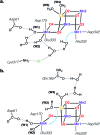A five-coordinate Mn(iv) intermediate in biological water oxidation: spectroscopic signature and a pivot mechanism for water binding
- PMID: 29861966
- PMCID: PMC5950799
- DOI: 10.1039/c5sc03124a
A five-coordinate Mn(iv) intermediate in biological water oxidation: spectroscopic signature and a pivot mechanism for water binding
Abstract
Among the four photo-driven transitions of the water-oxidizing tetramanganese-calcium cofactor of biological photosynthesis, the second-last step of the catalytic cycle, that is the S2 to S3 state transition, is the crucial step that poises the catalyst for the final O-O bond formation. This transition, whose intermediates are not yet fully understood, is a multi-step process that involves the redox-active tyrosine residue and includes oxidation and deprotonation of the catalytic cluster, as well as the binding of a water molecule. Spectroscopic data has the potential to shed light on the sequence of events that comprise this catalytic step, which still lacks a structural interpretation. In this work the S2-S3 state transition is studied and a key intermediate species is characterized: it contains a Mn3O4Ca cubane subunit linked to a five-coordinate Mn(iv) ion that adopts an approximately trigonal bipyramidal ligand field. It is shown using high-level density functional and multireference wave function calculations that this species accounts for the near-infrared absorption and electron paramagnetic resonance observations on metastable S2-S3 intermediates. The results confirm that deprotonation and Mn oxidation of the cofactor must precede the coordination of a water molecule, and lead to identification of a novel low-energy water binding mode that has important implications for the identity of the substrates in the mechanism of biological water oxidation.
Figures









Similar articles
-
Five-coordinate MnIV intermediate in the activation of nature's water splitting cofactor.Proc Natl Acad Sci U S A. 2019 Aug 20;116(34):16841-16846. doi: 10.1073/pnas.1817526116. Epub 2019 Aug 7. Proc Natl Acad Sci U S A. 2019. PMID: 31391299 Free PMC article.
-
Spin State as a Marker for the Structural Evolution of Nature's Water-Splitting Catalyst.Inorg Chem. 2016 Jan 19;55(2):488-501. doi: 10.1021/acs.inorgchem.5b02578. Epub 2015 Dec 23. Inorg Chem. 2016. PMID: 26700960 Review.
-
Redox Isomerism in the S3 State of the Oxygen-Evolving Complex Resolved by Coupled Cluster Theory.Chemistry. 2021 Sep 6;27(50):12815-12825. doi: 10.1002/chem.202101567. Epub 2021 Aug 6. Chemistry. 2021. PMID: 34288176 Free PMC article.
-
Implications of structural heterogeneity for the electronic structure of the final oxygen-evolving intermediate in photosystem II.J Inorg Biochem. 2019 Oct;199:110797. doi: 10.1016/j.jinorgbio.2019.110797. Epub 2019 Aug 1. J Inorg Biochem. 2019. PMID: 31404888
-
An evaluation of structural models for the photosynthetic water-oxidizing complex derived from spectroscopic and X-ray diffraction signatures.J Biol Inorg Chem. 2002 Jan;7(1-2):2-22. doi: 10.1007/s00775-001-0305-3. Epub 2001 Nov 8. J Biol Inorg Chem. 2002. PMID: 11862536 Review.
Cited by
-
Proton Translocation via Tautomerization of Asn298 During the S2-S3 State Transition in the Oxygen-Evolving Complex of Photosystem II.J Phys Chem B. 2019 Apr 11;123(14):3068-3078. doi: 10.1021/acs.jpcb.9b02317. Epub 2019 Mar 29. J Phys Chem B. 2019. PMID: 30888175 Free PMC article.
-
On the nature of high-spin forms in the S2 state of the oxygen-evolving complex.Chem Sci. 2025 Jan 31;16(9):4023-4047. doi: 10.1039/d4sc07818g. eCollection 2025 Feb 26. Chem Sci. 2025. PMID: 39898302 Free PMC article.
-
Arrested Substrate Binding Resolves Catalytic Intermediates in Higher-Plant Water Oxidation.Angew Chem Int Ed Engl. 2021 Feb 8;60(6):3156-3162. doi: 10.1002/anie.202012304. Epub 2020 Dec 10. Angew Chem Int Ed Engl. 2021. PMID: 33030775 Free PMC article.
-
Five-coordinate MnIV intermediate in the activation of nature's water splitting cofactor.Proc Natl Acad Sci U S A. 2019 Aug 20;116(34):16841-16846. doi: 10.1073/pnas.1817526116. Epub 2019 Aug 7. Proc Natl Acad Sci U S A. 2019. PMID: 31391299 Free PMC article.
-
Ammonia Binding to the Oxygen-Evolving Complex Probed by High-Energy Resolution Fluorescence Detected X-Ray Absorption Spectroscopy.J Phys Chem B. 2025 Apr 17;129(15):3776-3787. doi: 10.1021/acs.jpcb.5c00269. Epub 2025 Apr 3. J Phys Chem B. 2025. PMID: 40178509 Free PMC article.
References
-
- Blankenship R. E., Molecular Mechanisms of Photosynthesis, Blackwell, Oxford, 2001.
-
- McEvoy J. P., Brudvig G. W. Chem. Rev. 2006;106:4455–4483. - PubMed
-
- Krewald V., Retegan M., Pantazis D. A. Top. Curr. Chem. 2016;371:23–48. - PubMed
-
- Cox N., Pantazis D. A., Neese F., Lubitz W. Acc. Chem. Res. 2013;46:1588–1596. - PubMed
-
- Dau H., Haumann M. Coord. Chem. Rev. 2008;252:273–295.
LinkOut - more resources
Full Text Sources
Other Literature Sources

